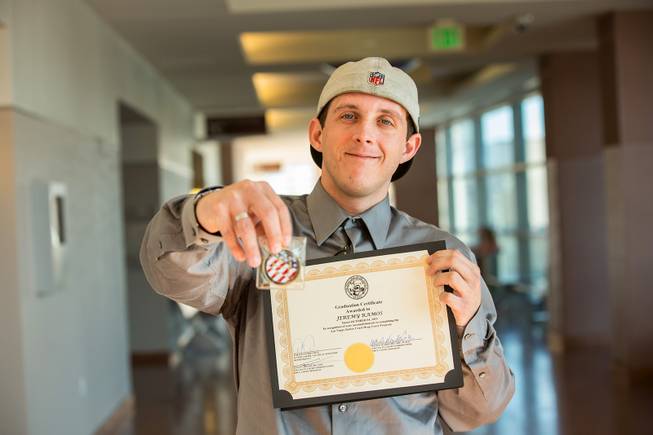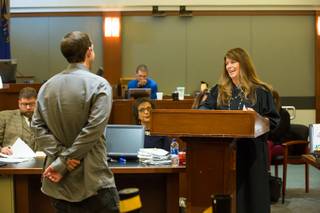
Jeremy Ramos proudly shows off his sobriety coin and graduation certificate for the Las Vegas Justice Court drug program, Friday, Oct. 4, 2019.
Sunday, Oct. 13, 2019 | 2 a.m.
Jeremy Ramos almost died three times because of his drug addiction.
Once, he was revived after his heart stopped for nearly four minutes at a Las Vegas-area hospital.
Another time, paramedics saved his life when he collapsed in front of a bank. Another time he received life-saving measures when someone called medical personnel after he was found unresponsive in the tunnels of the Las Vegas Wash.
The addiction led him to the tunnels in the first place. There, no one would judge him. Anything that would fit inside a needle, he would use— cocaine, crystal meth, heroin.
Addiction would keep him in those tunnels for seven years.
“There was a point where nothing mattered anymore,” he said. “I didn’t care whether I lived or died.”
But he got another chance at life after getting arrested. He was walking out of the wash with some cocaine and heroin he had just picked up and was about to do another shot when a police officer stopped him.
“He decided to take me to jail, and that was the start of the first change of my life,” Ramos said.
After being jailed, Ramos became a candidate for the drug court program offered at Las Vegas Justice Court. Officials say the goal is to get more repeat offenders off the street and on a path toward rehabilitation.
“You have defendants, when you look at their scope and wrap sheet for things like petty larceny and burglary, when you ask them if they were under the influence while doing these acts, that’s when you start to find out they’ve been using all along,” said Wanda Negron, the specialty court coordinator. “The average person doesn’t go stealing a car … addiction is a driving force. These things don’t always come up in the police report.”
Nevada has taken in thousands of participants since it started using drug courts in 1992. To get into the program, a defendant will plead guilty or no contest to drug-related charges. A judge will then decline to convict the defendant or suspend the case by putting the person on probation.
Funding is limited to 60 participants to annually enter the Las Vegas Justice Court program, yet on average, there are 14 addicts referred each month, officials said.
Las Vegas Justice Court is in the second year of a five-year plan to grow the program, using nearly $400,000 in annual grants from the Substance Abuse and Mental Health Services Administration to get more repeat offenders into treatment.
This gives participants a chance to treat their addictions through sober living and outpatient drug treatment, as well as medication-assisted treatment. Those arrested on certain felony charges can have those charges reduced to misdemeanors upon completion of the minimum 18-month program, Negron said.
More than half of new drug court referrals involve opioid dependence and at least five referrals a month are homeless, according to the court. The new grant funding will go toward enhanced counseling, random drug testing, co-occurring treatment, bus passes and workforce training.
Negron said once an individual is referred to the program, the criteria they have to meet from there is “pretty intense” and program noncompliance is not tolerated. Participants undergo formal mental health evaluations and regular drug screenings.
In her role as a program coordinator, Negron said she would typically look at the unique needs of a participant and try to cater the program to meet those needs, which may include connecting participants with a job, medical insurance, or arranging for government-issued identification.
The program has a 79% compliance-retention rate, officials said.
“The more they see themselves progressing the more apt they are to stay,” Negron said. “That reduces recidivism rates.”
Ramos, who graduated from the program earlier this month, said October marked his 18th month in sobriety. He works full-time as a cook on the Strip and hopes to go back to school. It’s worlds away from when he was living in the tunnels, but the journey getting there wasn’t easy.
He said he agreed to go into the program to avoid jail time, but shortly after getting accepted, he was on the run for almost a month. He was offered a choice; go back to drug court or spend six months in jail. He chose drug court.
“I almost died because they had me on something called the Vivitrol shot … it’s supposed to prevent you from getting high off heroin, and I decided to test the theory thoroughly,” he said. “When they found me, I was in worse shape than when they found me in the wash.”
Justice of the Peace Cynthia Cruz said Ramos’ case wasn’t uncommon, and that relapses were inevitable.
“A lot of people who have relapsed are still in the program,” she said.
Still, there are limits when it comes to second chances. “My joke is, ‘you can’t just be relapsing six times,’” she said.
Cruz’s courtroom isn’t structured like most. The atmosphere is informal, as Cruz passes out candy and sobriety coins to defendants for advancing in the program. Her rapport with them is amicable, addressing them by first name as she asks them with earnest, how they’re holding up.
“I like to be down on the floor with them,” she said. “They aren’t afraid to talk to me, and that enables them to find help instead of me being the judge that threatens to throw them in jail.”
During Ramos’ graduation, Cruz gave him a final sobriety coin, a certificate and a copy of his booking photo to remind him how far he’s come. Today, he’s unrecognizable from the man in that photo.
“It’s not like this (program) cures addiction,” he said. “I still think about using all the time, but the difference now is that I have the tools to not act on those impulses.”

